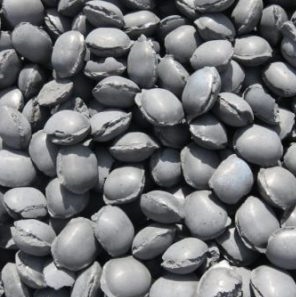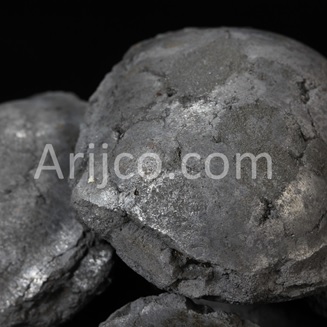Cold-molded briquettes are defined as DRI which has been molded at a temperature less than 650 °C or with a density of less than 5000 kg/m3. Due to the raw material sharp shortage for steelmaking in many countries worldwide, a need arises to find a substitute material to replace the rare pig iron and expensive steel scraps that were used by steelmaking plants.
Pellet DRI is a spongy, metallic material produced by the reduction (oxygen removal) of iron oxide (FeO) at temperatures below the melting point of iron.
Note: CBI is the acronym for different phrases. This article is unrelated to “Central Bank of Iran”, “Centre for the Promotion of Imports”, “Central Bureau of Investigation”, “Confederation of British Industry” and “Central Board of Indirect Taxes and Customs”

Cold Briquetted Iron (CBI)
During the steel production where Sponge Iron (DRI) is applied as a raw material, large quantities of undersized particles and fine are made which are not useful to be used in steelmaking. These metallic particles and fines are formed into the briquettes using sodium silicate (Na2SiO3) as the binder and lime as the flux. The formed briquettes are referred to as cold briquetted iron (CBI) since they are compacted while the fines are cold.
In other words, cold-molded briquettes produced from fines and by-products, that generated during the process of production, storage, and handling of DRI are known as “Cold Briquetted Iron (CBI)” in direct reduction (DR) industries.
Besides boosting fines utilization, the cold briquetting system has been happened to be a very significant development in handling and storage of Midrex DRI (sponge iron). Low surface space of these high-density briquettes can increase their resistance to re-oxidation around 5 – 6 g/cm3.

Cold Briquetted Iron and Carbon (CBIC)
According to IMSBC, CBIC is a new product derived from the densification of pellet Sponge Iron (DRI B) at ambient temperature.
In this process, pellet DRI turns into the briquettes through roller presses. Adequate free carbon content required in steelmaking furnaces (0-10 wt %) could be added to CBIC during the process of briquetting. In other words, CBIC is a metallic material molded in briquette shape, derived from a compressing process through which pellet DRI is fed into the roller presses at room temperature.
Special Characteristics of CBI and CBIC
CBI and CBIC carbon content control is completely achievable and practical and can be produced according to the customers’ orders. Controlling the carbon content of Cold Briquetted Iron for possible uses of this product in electric arc furnace (EAF) and induction melting furnaces (IMF) results in various direct reduction (DR) processing conditions.
Source:
- Journal of Minerals & Materials Characterization & Engineering, Vol. 7, No.1, pp 39-48, 2007
- https://edocs.imo.org/Final Documents/English/CCC 2-5-13 (E).docx



